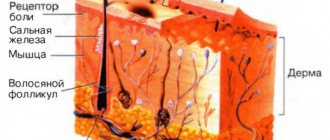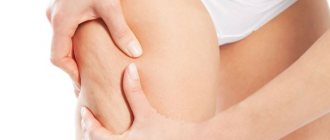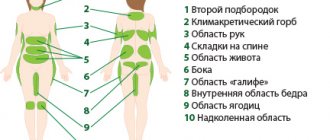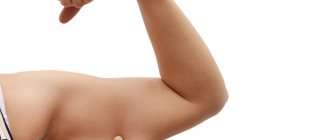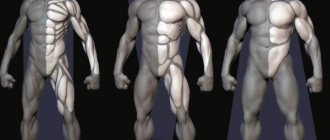Cellulite is an inflammation of the subcutaneous tissue, usually non-purulent, spreading along the connective tissue in the intercellular space. For various reasons, the cells of the subcutaneous fat layer can greatly swell, thicken and put pressure on the upper layers of the skin. The connective tissue fibers located between the fat cells are not able to increase enough to properly support these fat cells. Therefore, small bumps appear in the affected areas of the skin, and the skin begins to resemble a “quilt.” This hallmark symptom of cellulite can be easily seen when you lightly squeeze the skin with your fingers. At the same time, folds appear and the skin resembles an orange peel.
Stages
The definition of cellulite sounds like pathological structural changes in the subcutaneous fat layer, leading to stagnant processes - impaired lymphatic drainage and microcirculation. In medicine, this is usually called the scientific terms “lipodystrophy” or “liposclerosis”.
There are four stages of development of the defect:
- At the initial stage, there is only a slight stagnation of fluid, which manifests itself in slight swelling and sagging of the skin. The problem is still completely invisible, so it often goes unnoticed. But it can be solved by adjusting the diet and increasing physical activity.
- Then the connective fibers thicken, lymph outflow and blood circulation worsen.
The skin becomes less elastic, and after pressing with a finger, indentations remain on the surface for a few seconds. The unevenness is already clearly visible to the naked eye and can be felt. - At the third stage, an orange peel is formed - hard nodular seals.
The skin loses sensitivity and takes a long time to warm up due to lack of blood, which cannot pass through the compressed vessels. Fat begins to gradually be deposited in other parts of the body.
Physical exercises are no longer effective, since the muscle tissue also becomes rougher, stops contracting fully and is difficult to tone.
- The fourth form
is characterized by tubercles, depressions, potholes, blue skin, severe swelling, muscle atrophy, as all changes and disorders progress. Even minor bruises or simple pressure cause hematomas.
If the fat layer is compressed, severe discomfort appears. This advanced process, when cellulite hurts, often develops on the buttocks, legs or abdomen. Less often - on the upper arms, knees and legs.
What is cellulite
Let us remember that subcutaneous fat (hypodermis) consists of collagen and elastin fibers, which intersect with each other and form a “honeycomb”, enveloped in blood vessels and nerves. Fat cells (adipocytes) live in these honeycombs.
If there is too much fat in the body, it begins to actively accumulate. Adipocytes swell from the amount of fat filling them, they become cramped, they begin to push, clump, stick together and form “lobules.”
The lobules, in turn, begin to push the walls of the honeycomb, bulge unevenly and deform the surface of the skin. That's why we see bumps and depressions on the surface of the skin, which we call cellulite (or "orange peel").
The correct medical name for cellulite is gynoid lipodystrophy.
But cellulite is not “just excess fat”; it is a change in the structure of subcutaneous fat that disrupts blood microcirculation and lymph flow. Which, in turn, leads to stagnation in the hypodermis and its degeneration.
Cellulite spreads its tentacles to the entire subcutaneous fat tissue - the vascular system, nerves, fibers, adipocytes, intercellular substance.
Cellulite is a closed dead zone where the necessary nutrients cannot penetrate the tissues, and metabolic products (slags and toxins) cannot find a way out. As a result, intoxication of the hypodermis occurs and permanent scars are formed.
How cellulite is formed
- Adipocytes are growing.
- The nerve endings are pinched, as a result of which the tone of the blood vessels and the sensitivity of the skin change, and painful sensations arise when pressure is applied.
- Blood circulation and lymph flow become difficult, hypoxia (lack of oxygen) occurs in the tissues.
- Under hypoxic conditions, collagen and elastin lose their elasticity and form rough partitions - the effect of “walled cells”.
- Metabolic products - waste and toxins - accumulate.
- Intercellular edema appears.
- Isolated clusters of cells (lobules) and scar (fibrous) changes are formed that look like an orange peel, a bunch of grapes, or the surface of a mattress.
Favorite locations for cellulite are the buttocks, thighs, abdomen, sides of the knees, shoulders and the area from the elbow to the shoulder.
Causes of pain
- Adipose tissue is formed from a strictly defined number of lobules, the number of which does not change throughout life.
- They consist of round cells - adipocytes, surrounded by collagen fibers and blood capillaries.
- The contents of the ball are fat, the excess of which causes the cell to increase to a critical size.
- Then the reproduction process starts, due to which the number of adipocytes in the tissue lobules increases sharply.
- As a result, they compress the capillaries, disrupting blood circulation and the supply of nutrients, as well as the removal of toxic compounds.
Over time, swelling, nodes and scar changes appear. Fibrous tissues become increasingly denser and harden. On the outside, the skin appears uneven and covered with hard bumps. The exact causes of pathological cell proliferation have not been established.
- bad heredity;
- hormonal disorders;
- unhealthy diet and systematic overeating;
- sedentary lifestyle;
- slagging of the body;
- endocrine diseases (diabetes mellitus, thyroid or adrenal dysfunction);
- frequent stress and nervous tension.
It is important to understand that it is not cellulite itself that hurts, but tissues and blood vessels that do not receive oxygen and nutrition. Pain in most cases is a symptom of a disease that occurs against the background of structural changes in fat cells.
If any discomfort occurs, you should definitely consult a specialist and rule out other health problems, including hormonal and endocrine disorders.
Cellulite. Causes, treatment, exercises.
What is cellulite?
The problem of cellulite can be defined as the tendency of adipose tissue to retain fluid. The result is swelling that compresses adjacent areas of connective tissue, which in response produces dense collagen fibers that insulate lumps of fat and impede blood circulation. In this case, characteristic tubercles gradually form in the subcutaneous tissue. Sometimes due to poor circulation they become inflamed and painful.
Why does cellulite occur only in women?
One of the causes of cellulite is the action of female sex hormones - estrogens. In men, the concentration of these substances in the blood is extremely low: therefore, they almost never encounter this problem. In women, cellulite occurs in 80-95 percent of cases.
When does cellulite occur?
Cellulite usually appears during hormonal changes in the body: puberty, pregnancy, menopause. The most vulnerable places are the hips, buttocks, stomach, and side surface of the torso. Thus, it can be argued that cellulite most often occurs during the period of “hormonal surges.”
Which fat layer is prone to cellulite?
The entire fat mass of the human body is divided into three layers, which differ from each other in location and metabolic characteristics. It is generally accepted that the number of adipocytes (fat cells) in an adult is fairly constant. This means that an increase in the amount of fat is associated not with an increase in the number of fat cells, but with an increase in their volume. The diameter of adipocytes can increase 30-40 times depending on the degree of obesity and the characteristics of adipose tissue.
The first layer is the most superficial, located between the skin and the muscle fascia - a thin film covering the muscles. It is on this layer that the outlines and proportions of a person’s figure mainly depend, that is, it is the layer that is “responsible” for fullness. The first layer is located on the entire surface of the body, and it is actually this layer that is affected by cellulite.
The second layer of fat mass is deeper, located under the muscle fascia. Its volume is more or less constant and does not change with general weight loss in the body. The third fat layer - internal (visceral) - is located inside the abdominal cavity. Hypertrophy - excessive increase in this layer - is more typical for men and is expressed in the form of large bellies.
The mechanism of cellulite occurrence.
The occurrence of cellulite is based on two main processes: a local increase in fat cells and impaired microcirculation in adipose tissue. Normally, two main processes constantly occur in a fat cell: lipogenesis (fat synthesis) and lipolysis (its destruction). In pathology, the first process prevails over the second. As a result, the cell increases in size, begins to compress nearby vessels and protrudes into the dermis. Accordingly, the skin turns into the so-called “orange peel”, and venous outflow (usually from the extremities) slows down noticeably. Let's look at this process in more detail at the cellular level.
Cellulite is a modification of the fatty tissue of the skin. Female hormones - estrogens - are to blame for this (one cause of cellulite). They are able to affect blood vessels in the subcutaneous fat, clogging them, increasing capillary permeability, which leads to swelling and deterioration of microcirculation. Less oxygen and nutrients reach the body's tissues. Under conditions of lack of oxygen, the formation of connective tissue fibers surrounding groups of fat cells increases, and fibrous capsules begin to form. The presence of these capsules further worsens the metabolic processes between fat cells.
To this is added slagging in the body (due to poor nutrition and slow metabolism). Since toxins accumulate in fat, cells affected by cellulite contain a huge amount of waste. In the body, fat cells are arranged like a honeycomb. These cellular tissues become filled with toxin-laden fatty deposits, which push the skin upward and outward (i.e., stretch). This stretches the collagen, the tension of the collagen restricts the movement of fluid and impedes circulation.
Blood hormones that promote the release of fat cannot penetrate the cellulite-affected cell to trigger the fat outflow mechanism. As a result, the cell continues to absorb fat and cannot effectively release it when the body needs it. In turn, toxins and fluid pressure cause cell deformation - fat cells increase in size, compress surrounding tissues and blood vessels, aggravating metabolic disorders in them; the elasticity of collagen and elastin fibers decreases; lymph flow and blood microcirculation deteriorate. As a result, fluid and fat accumulate under the skin, which looks like an orange peel. Depending on the stage, a bluish tint of the skin in the affected area, compression of arteries and veins, and the appearance of capillary networks are observed.
Stages of cellulite.
The first stage is the “mild edema” stage. The skin is even and smooth, the subcutaneous fat layer is soft on palpation, the main manifestation is that the skin appears swollen in appearance.
Indeed, the body begins the process of fluid retention in fat cells, the reason is the insufficiently efficient functioning of the lymphatic system. Adipose tissue is formed by fat cells, the space between which is penetrated by a network of connective tissue fibrous and elastic fibers, together with which they form fat lobules. Along with the connective tissue, a huge number of lymphatic and blood vessels pass through. The lymphatic system can be called the main “drainage” system of the body, up to 65% of fluid and waste (in our case from fat cells) is removed through it, the rest is removed through the venous circulatory system (it is the intensive work of the venous system at this stage that ensures that the process is not externally visible) . The small arterial system (arteriolar system) provides the supply of oxygenated tissue. A stimulator of good functioning of the lymphatic and venous system is physical activity and natural outflow, therefore all the shortcomings of civilization associated with physical inactivity and being in forced positions, and all against the backdrop of slagging in the body, are precisely the cause of the development of cellulite.
The second stage is the stage of “dense edema”. With the same external manifestations, the subcutaneous fat layer is hard on palpation. Subcutaneous fat becomes more dense, since at this stage not only the lymphatic, but also the venous system can no longer cope with removing fluid from the body, and dense lymphostasis (impaired lymph outflow) of fat cells occurs. The connective tissue of the subcutaneous fatty tissue, as in the first stage, is not changed.
Externally, you can notice the appearance of “ripples” on the skin - small irregularities that resemble small waves.
The third stage is the “orange peel” stage. The skin seems normal, but if it is folded, small nodular compactions and retractions between them become noticeable, which looks like an orange peel; in areas of cellulite, the skin temperature of the body is usually slightly lower than in other areas; pinching in cellulite areas is often painful sensations. It is believed that at this stage not only the venous outflow is affected, but also the arterial supply through small vessels - arterioles. Under conditions of oxygen starvation, connective tissue begins to intensively develop around adipose tissue, turning into dense, low-extensibility (sclerosed) cords. Connective tissue is normally present in the subcutaneous tissue, in the form of a mesh surrounding fat cells and attached to both muscle and skin. With excessive development and sclerosis, the extensibility of the connective tissue decreases, which creates retractions on the skin and pain, and dense nodules are fat cells with the phenomena of dense lymphostasis.
The fourth stage is the stage of “cellulite bumps”. Nodular compactions become visible to the eye in the form of bumpy areas of skin, the skin is cold, pale with a bluish tint, with a visible mesh of the venous system; it is impossible to take the skin into a small fold due to the density and soreness of the subcutaneous tissue. At this stage, not only the connective tissue, but also the fat cells are subject to sclerosis; a so-called “cellulite nodule” is formed, which is detectable to the touch and visible on the surface in the form of characteristic bumps.
The main factors contributing to the occurrence of cellulite.
- Hormonal status . Undoubtedly, female hormones play a leading role in creating favorable conditions for the formation of cellulite: they have a positive effect on the development of adipose tissue and on water retention in the body, which occurs mainly in the hips and pelvis. However, in fact, hormones only “prepare the ground” for this problem to arise; we do the rest ourselves.
- Hereditary predisposition . It matters, but just like hormones, it manifests itself only when the combination of other factors is favorable for cellulite.
- Poor nutrition. This concept includes not only a qualitative and quantitative imbalance of food products (lots of animal fats and refined carbohydrates, processed foods, smoked meats, etc.; few vegetables, fruits, clean water, etc.), but also a disrupted nutritional culture: how often do we snack “on the run”, without having time to chew the food, we eat whatever comes to hand if we feel hungry. This also includes the periodically arising desire to “eat up” stress and troubles with something tasty, but, alas, of little use. It is especially important to give up “artificial” additives – dyes, flavors and taste imitators. This category also includes carbonated drinks such as cola, sprite and forfeit. Nothing more useful than clean water has been invented as a tool for cleansing the body of toxins.
- Sedentary lifestyle. For many of us, sitting for long hours at work is a daily reality. However, we often continue to follow this tradition in our free time: we spend too much time sitting at home in front of the TV, at the computer, or simply in pleasant company. At the same time, we forget that a sedentary lifestyle is characterized by improper blood circulation, shallow breathing, weak lymph flow, and stagnation in the intestines, which later leads to serious health problems and the development of cellulite.
- Violation of blood and lymph circulation. In order for cells to receive adequate nutrition and tissues to remain healthy, smooth and elastic, the exchange of nutrients and waste products must take place continuously and without interference. This, in turn, is ensured by the normal functioning of the blood and lymph circulatory system. Cells function effectively only when harmful substances are promptly removed and excess fluid does not accumulate. If the speed of lymph circulation is slowed down for any reason, accumulation and stagnation of intercellular fluid occurs in the tissues. In those places where the speed of movement of lymphatic fluid is especially low, for example in the pelvis and hips, congestion provokes the formation of cellulite. Therefore, the state of the internal environment of the body plays a significant role not only in our general well-being: but also in how we look and what shape our body has.
- Stress and bad habits. Stress in the nervous system and excessive anxiety have a destructive effect on all systems of our body, affecting digestion, blood circulation, the functioning of the excretory systems, disrupting normal sleep and reducing vitality. The consumption of nicotine, caffeine and alcohol leads to the fact that hormones, performing their protective functions, transport all waste and toxins to safe parts of the body so that you can survive in this situation. Smoking is harmful not only to the skin and lungs. It causes a narrowing of the capillaries, thus weakening the protective and regenerative functions of the skin. In addition, smoking promotes the destruction of connective tissue, which also leads to the appearance of “orange peel.” Of course, it is impossible to take into account all factors and always adhere to all the rules, but you can eliminate everyday “small” bad habits.
Sitting with crossed legs disrupts normal blood circulation in the lower extremities, since in this position one of the main veins of our body, running along the inner surface of the thigh, is compressed
Wearing high-heeled shoes for a long time deforms the calf muscle and disrupts normal blood circulation in the lower extremities. In addition, artificial heel elevation changes posture, which creates additional problems for the normal functioning of internal organs.
Wearing tight clothing, belts, belts, tight underwear and tights leads to congestion above or below the point of constriction.
Treatment of cellulite. Only a complex of anti-cellulite measures will give a quick, noticeable and long-term effect. A diet without special cosmetics, a massage without muscle training - none of these measures on their own will do anything. But if you simultaneously conduct a targeted fight on all fronts, any cellulite will disappear (or go to a smaller stage), and if certain conditions are met, it will not appear again.
Basic principles of cellulite treatment:
- reducing fat synthesis;
- stimulation of fat breakdown;
- improving skin elasticity;
- stimulation of tissue fluid outflow - lymphatic drainage;
- stimulation of peripheral venous and arterial circulation;
- stimulation of muscle function;
- breaking up “fat nodules”, stretching fibrous fibers in subcutaneous fatty tissue.
At each stage, individual complex treatment is required.
The main task of fighting cellulite at the first stage is to remove fluid and toxins from the body. The main method of struggle is a healthy lifestyle with systematic physical exercise. Proper nutrition with the exception of carbohydrates and fats, canned foods and preservatives, more fruits and vegetables. General detoxification of the body with diet, sauna, periodic self-massage and massage provide a positive effect.
At the second stage, it is necessary to add therapeutic methods to the above preventive methods. A special diet, a set of physical exercises, a special massage with anti-cellulite and tonic creams, lymphatic drainage using pressotherapy (pneumatic massage), cupping massage, local detoxification methods (general and local wraps). Electrical stimulation of muscles in affected areas.
To treat cellulite at the third stage, consultation with doctors and a larger number of procedures, long-term cleansing of the body with diet are necessary. Anti-cellulite manual and hardware massage, when fat nodules are removed, to increase efficiency, the massage is performed in combination with special creams and wraps containing caffeine, ivy and chestnut extract, ginseng, jojoba, extracts from algae and silt and other substances that promote weight loss.
Vacuum massage using special equipment (vacuum pulsating, vacuum compression, vacuum sliding - often called cupping). Cryotherapy with special equipment or by applying menthol and camphor oil (cold wraps). Thermotherapy - general and local heating (steam room, wraps), including with the help of ultrasound. Local administration of drugs (mesotherapy).
How many sessions will it take to combat cellulite?
Just as there is no other person like you, there is no single program to combat cellulite. The number of procedures to get rid of cellulite will depend on the stage of cellulite, the condition of the skin, contraindications to the procedures and some other points. At an in-person appointment, the master recommends the optimal course of hardware cosmetology of one or another method or combination of methods, massage and detoxification of the body. Treatment of cellulite is a complex problem that requires patience and consistency from the patient. Experts recommend adhering to a certain course of procedures; only in this case will cellulite treatment be effective and the results lasting. If you interrupt the course, you will have to start the fight against cellulite all over again. There are no “universal” methods, information that cellulite can be cured using only a special cosmetic product, a physiotherapeutic device, etc. - nothing more than a publicity stunt. Successful treatment of cellulite is an individually designed anti-cellulite program, the result of joint actions of you and your specialist.
Is it dangerous
If pain is present, it means that cellulite has already entered the last fourth stage. Which is dangerous, since blood circulation in the pathological area is completely disrupted.
This leads to the development:
- varicose veins - thinning of vascular walls and the formation of nodes;
- thrombophlebitis - the formation of a blood clot and inflammation of the veins.
The quality of life is significantly impaired - the woman constantly feels pain, heaviness in her legs, fatigue even after short walks, and severe tension. It is quite difficult to overcome advanced changes in adipose tissue, but it is possible. The main thing is not to give up and use all available methods.
Should you see a doctor?
It is impossible to independently identify cellulite in the early stages. Even a doctor is not able to determine the presence of a problem by eye. Lumps that form when the skin is squeezed by the thumb and forefinger may well be the first symptom of pathology.
But such a reaction also occurs on healthy female integuments, which is due to the typical structure of connective tissue.
They speak with confidence about the presence of cellulite when bumps and indentations are present even without compression.
Diagnostics are carried out on modern equipment using computer technology. When the process just begins, it can be stopped with a balanced diet, exercise and massage.
Why cellulite appears in men and children
In addition to the above-mentioned causes of cellulite, hormonal disorders will be relevant for men. Yes, women had the same preconditions. However, in the case of men, slightly different mechanisms work. The fact is that the body of the stronger sex also contains estrogen, but in extremely low concentrations. The female hormone maintains the level of “good cholesterol” at the required level, and also normalizes the functioning of the heart and blood vessels. In addition, estrogen improves a man's brain activity. However, the beneficial properties of the female sex hormone are relevant only as long as its level in the blood is 10 units less than the same level of testosterone. The amount of estrogen, in turn, directly depends on lifestyle. For example, drinking beer contributes to a gradual increase in the female sex hormone in a man’s body, as a result of which a member of the stronger sex develops a “beer belly” and sometimes cellulite. The following factors also affect estrogen concentration: aging, long-term lack of sexual activity and smoking.
Read more about cellulite in men in the article - Cellulite in men: causes and methods of fight.
A man's favorite drink (beer) helps to increase the level of estrogen in the body.
As for children, at an early age the main cause of cellulite, as a rule, is a hereditary predisposition. Of course, pathology is found extremely rarely in boys and girls. But if this happens, then you should pay attention to the child’s lifestyle. Perhaps he eats a lot of junk food and constantly sits at the computer. In this case, you should try to instill in your child a love of outdoor games and healthy foods. However, if everything is fine with the child’s lifestyle, consult a doctor: an endocrinologist and a therapist. Perhaps the reason for the development of pathology lies in a hormonal imbalance or a serious illness.
Children who like to spend time on the computer are most susceptible to cellulite formation.
What to do if cellulite hurts
First, you need to completely reconsider and change your lifestyle:
- balance your diet.
Introduce more fresh fruits, vegetables, herbs, natural juices, and cereals into your daily menu. Instead of bread made from wheat flour, eat bran products. Completely exclude fatty meats, sausages, smoked foods, sugar, chocolate, fast food. It is useful to boil food, steam it, or cook it in the oven; - get rid of the habit of snacking on the go.
Eat often 5-6 times a day, but in small portions. At the same time, you should not adhere to too strict diets, as hunger will only aggravate the problem; - drink at least 2 liters of water per day, not counting compotes, juices, green tea and soups.
Avoid alcohol, sweet carbonated drinks, instant coffee, strong black tea; - quit smoking. Toxins and poisons contained in resins slow down the synthesis of new cells and tissue regeneration;
- maintain physical activity.
It is very important to spend as little time as possible on the couch at home, as this further impairs blood circulation. You can do gymnastics, swimming, dancing, walking and other non-strength sports; - Regular cosmetic procedures increase the chances of returning the skin to its previous condition.
These are scrubs and peelings, baths, wraps, contrast showers, various types of massage, hardware procedures, and the use of special creams and gels.
Secondly, at the third and fourth stages, cellulite treatment should be carried out by a cosmetologist. The selection of the most effective methods is carried out individually, since they all have contraindications.
A woman may be offered:
- lymphatic drainage
is a physiotherapeutic method of removing excess fluid and toxic compounds from the intercellular space. It is carried out by hardware galvanization, vacuum, microcurrents or manual massage; - cellulolipolysis
- splitting and getting rid of fat by inserting needles under the skin and applying electric current; - thermolifting
– thermal treatment that activates the work of fibroblast connective tissue cells, affecting the production of collagen and elastin; - ultrasonic massage
– breaking up fat deposits and removing them from the body along with decay products naturally; - Pressotherapy
is the effect of compressed air on the body, which relieves swelling, which helps reduce volume in problem areas.
Food is a provocateur of cellulite
Our nutrition is our closest contact with the outside world. Everything we put in our mouths enters the bloodstream and is carried throughout all the cells of our body, affecting each of them. The body absorbs both beneficial and harmful components from food.
The appearance of cellulite does not depend on the amount of food consumed, but on its quality. Those at risk for cellulite are those whose diet consists of refined foods (sugar, white flour), fast food with an abundance of saturated fats, chemical food additives, preservatives and salt. Such food cannot provide us with the necessary vitamins and microelements, and as a result, the body is not able to remove all toxic substances that come from the external environment along with air, food, or are formed during the digestion process. Simply put, metabolism in cells is disrupted and toxins accumulate in connective tissues.
If the problem appeared after childbirth
During pregnancy, a woman's body and lifestyle undergo numerous changes.
Almost all of them aggravate the problem of cellulite:
- hormonal surges;
- slowing down metabolism;
- weight gain;
- low physical activity;
- overeating and indulgence in sweets and flour products;
- delayed fluid excretion and swelling;
- lack of vitamins and minerals, especially iodine and magnesium.
Even if before pregnancy there were never any problems with excess weight, and the skin was perfectly smooth, then for 90% of girls everything changes within 9 months. The good news is that these are all temporary phenomena that easily disappear after some period of time after childbirth.
The fact is that the connective tissue cells of the skin in women are more elastic than in men. This is how nature took care of the body’s ability to bear and give birth to a child. But for the same reason, adipocytes are not restrained by the frame and can be filled to capacity with fat, grow and multiply.
The body tries to put aside as many reserves as possible in case it stops receiving nutrients from the outside. If a young mother takes timely measures and begins to take care of her health, then after stabilizing the level of hormones and metabolism, the signs of the orange peel will go away.
Cellulite is the fibrosis of fatty tissue with the formation of compacted areas under the skin of the thighs and buttocks. For a long time, this condition was considered a secondary sexual characteristic for women, but now girls are actively getting rid of the symptoms of liposclerosis and often consult a doctor for qualified help with cellulite.
Causes or risk factors for the development of pathological syndrome
:
- burdened heredity;
- disturbance of microcirculation in blood and lymphatic vessels;
- hormonal imbalance;
- physical inactivity;
- presence of bad habits, in particular smoking;
- poor nutrition;
- frequent changes in body weight (while obesity is not a predisposing factor for cellulite);
- stressful situations.
Treatment
Good prevention of cellulite is active movement and moderate nutrition. Sport is the real enemy of cellulite. And if fat deposition has already occurred, it can be eliminated with the help of physiotherapeutic procedures.
Women should regularly examine their thighs, buttocks, and facial skin. It is necessary to squeeze the skin with two fingers until a kind of “fold” forms. If a characteristic “orange peel” is visible when compressed, then you should consult a doctor.
After collecting anamnesis, checking the skin and performing tests, the doctor will determine the cause of inflammation of the subcutaneous tissue. If necessary, prescribe medications.
Cellulite caused by excess weight is an unpleasant cosmetic defect, but it is completely harmless. If the disease is caused by inflammatory or infectious processes, then large areas of skin or even internal organs may be affected.
Tea against cellulite
You need to drink three cups of this tea a day. To prepare, you need to mix 10 g of hops, 30 g of sorrel roots, 30 g of asparagus roots, 30 g of ash leaves, 20 g of buckthorn bark. Pour one spoon of this mixture into 1 liter of water and boil over low heat for 10 minutes, then strain and drink.
As soon as the first signs of orange peel appear on the skin, they do not cause any discomfort. Except that the small tubercles still look rather unattractive.
However, some women experience cellulite pain. To find out why this happens, it is necessary to take a closer look at the stages of the disease, as well as find out the causes of discomfort.
How to determine if you have cellulite?
Before thinking about which doctor to contact, a woman should make sure that she has cellulite. To do this, you need to take a fold of the skin on the thigh and squeeze it. In the case of pathological sclerosis of fat, the result will be a lemon peel. In neglected forms, the process is visible visually.
There are several stages of cellulite
:
- Pre-cellulite stage. There are no visible signs of the pathological process, other than an increased tendency to bruise. However, tissue nutrition has already started, lymph outflow is difficult, and capillary permeability is increased.
- Initial stage. Here, blood flow and oxygen supply to adipose tissue are disrupted, due to which the elasticity of the skin is reduced. When folded, the skin looks like an orange peel.
- Micronodular. Noticeable swelling of the tissues appears, and the partitions in the fatty tissue become denser. The appearance of orange peel in the affected areas is visible without special testing methods. Single nodules can be felt under the skin.
- Macronodular. Pronounced nodes fused to the skin appear. They are painful when pressed and are characterized by a local increase in temperature, which indicates inflammation.
The doctor treating cellulite pays attention to the neglect of the process in order to immediately inform the patient about the expected results. The more pronounced the liposclerosis, the less likely it is to get rid of it.
Cellulite Options
The following types of cellulite are distinguished:
- Fibrous. Typical for young people under 25 years of age. It is characterized by pain when pinched and dense structure. To treat it, it is recommended to focus on physical activity.
- Fatty. It is typical for women from 25 to 40 years old. There is no painful sensation on the skin when pinched. She is flabby and soft. Formed on the thighs. The culprits are a sedentary lifestyle and a passion for overeating. Treatment, in addition to sports activities, should be based on a diet with limited fat.
- Hydropic. This type is typical for the elderly, as well as for those who move little. In addition to cellulite changes, swelling occurs. For treatment, massage, electrical stimulation, and physical exercise are more effective than other methods. It is much easier to prevent it than to get rid of it later. This includes proper nutrition, moderate physical activity, and contrasting water procedures. Preventive anti-cellulite products will not be superfluous.
Which doctors can help with the problem?
Cellulite is a problem of multifactorial origin, so several specialists must deal with it at once. The main doctor for cellulite is called a cosmetologist, because only for him the appearance of the patient is of paramount importance. In general, the following doctors can deal with the pathological process:
:
- Endocrinologist. An endocrinologist will identify any imbalances and correct them. Almost all patients with progressive forms of cellulite have problems with hormones.
- Phlebologist. The initial stage of liposclerosis is characterized by venous stagnation, which requires correction by a qualified doctor. In some cases, for example, with inflammation of varicose veins, surgical manipulation is required.
- Gastroenterologist. Helps fight gastrointestinal problems, due to which nutrients are not absorbed into the blood or body weight constantly changes.
- Nutritionist. The doctor will adjust your diet, help you lose excess weight and achieve its stabilization.
- Massage therapist. Kneading the affected areas is a good additional treatment. However, an isolated massage will not help get rid of cellulite.
- Cosmetologist. Treatment of cellulite in most cases begins with a visit to this doctor, who operates with local means of influencing adipose tissue. In the initial stages of pathology, they can be quite effective.
- Physiotherapist. There are many different techniques that doctors use to break up lumps and knots on the thighs and buttocks.
- Plastic surgeon. This doctor surgically removes sclerotic fatty tissue.
Women vs. Men
Sadly, cellulite is a women's problem. In men, even plump and loose ones, it occurs extremely rarely. Why such injustice, you ask?
For the average healthy man without excess weight, fat makes up 12% of body weight, for women - 25%.
In addition, the arrangement of collagen and elastin fibers is different in men and women. In men, these fibers separating the lobules are located at an angle, and in women, they are perpendicular to the surface of the skin and parallel to each other. Plus, male lobules are much smaller than female ones.
Thanks to this, swollen adipocytes practically do not change the relief of men's skin, and in women dimples and tubercles appear - the notorious orange skin.
Cellulite, to some extent, is a secondary female sexual characteristic and depends on the phase of the cycle, pregnancy, and menopause. This applies to the initial stages, the final stages are already a serious and not even an aesthetic, but a medical problem.
Morality - you can’t go against nature. Humble yourself. Everyone has subcutaneous fat, and even in the absence of excess weight and swollen adiocytes, the collagen and elastin fibers that frame the lobules can stretch, sag, be damaged or tear - and this is a direct path to the “orange skin.”
No matter how much you want, you will not be able to rearrange the collagen and elastin fibers and push the slices so that they lie smoothly and beautifully. That is why even models who eat pollen and heavenly nectar and are actively involved in sports can have cellulite.
Features of treatment and prevention of cellulite
Therapeutic measures for this disease rarely lead to complete recovery. Even plastic surgery does not guarantee the absence of recurrence of the pathology. Therefore, during the treatment of cellulite, the doctor tries to achieve the most positive result and stop the progression of the disease.
Treatment with professional means or at home may not produce results at all in advanced cases, and the patient should be prepared for such an outcome. However, it is still recommended to contact professional doctors who will conduct a comprehensive diagnosis of the body and act on the root cause of cellulite.
In order not to suffer all your life with this pathology, it is better to try to prevent its occurrence. To prevent cellulite, doctors recommend:
- Healthy food;
- exercise;
- undergo preventive examinations in medical institutions for early detection of various diseases;
- to refuse from bad habits;
- use cosmetics even before the obvious progression of the disease.
Unfortunately, cellulite affects almost all girls, regardless of lifestyle
How to get rid of cellulite that appears
Unfortunately, you cannot get rid of cellulite simply by losing weight. How to fail to get rid of it with the help of gymnastics. The fact is that these changes are a health problem, and not just a cosmetic defect.
The main goal of cellulite treatment is to maximize the restoration of microcirculation, the volume of blood flow in it, thus optimizing the delivery of nutrients, oxygen and the removal of toxins and metabolic products.
Only an integrated approach to treatment can be effective:
- Nutrition optimization. Good old fashioned proper nutrition and lifestyle is recommended. It is worth excluding fried, fatty, smoked, salted, sausages, confectionery delights, and baked goods. Sugary carbonated drinks should be replaced with clean water. The norm for its consumption per day is about 2 liters.
- To give up smoking. Nicotine can narrow the lumen of the capillaries, destroying vitamin C, which prevents this.
- Sports activities. It is regular physical exercise that will activate blood flow throughout the body, including the pancreas.
- Massage with anti-cellulite effect. This method, used separately, will be effective only in its earliest stages. Its effectiveness will be noticeable with a full range of treatment: physical education, therapeutic agents.
- Anti-cellulite medicinal creams. They are effective when used together with massage.
- Cold and hot shower. Makes blood circulation work more actively, blood vessels quickly change their tone with changes in contrasting water temperatures.
- Wrapping is effective as an additional remedy. These procedures activate blood circulation, fill the skin and fatty acids with vitamins, and remove toxins from the epithelium of the skin.
- Sauna and Russian steam room.
Whatever methods are used in the treatment of cellulite, the greatest effect can be achieved only if they are used comprehensively and regularly. In addition, you need to be prepared for the fact that the body, especially the female body, is extremely reluctant to give up what it has accumulated in reserve. You just have to be patient and then the result will definitely come.

